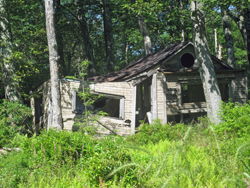From the parking area, walk around the gate and take the left fork of the Loop Road (a gravel road, closed...
Hike Description:
From the parking area, walk around the gate and take the left fork of the Loop Road (a gravel road, closed to private vehicles, but open to service vehicles). Follow the road uphill, passing several dilapidated shacks on the left, built to house the “berry pickers” who lived there seasonally while harvesting the blueberries and huckleberries which are found in abundance in the area. In 0.3 mile, a wooden sign on the left marks the start of the South Gully Trail, the route of the aqua-blazed Long Path. Continue ahead on the gravel Loop Road, which now levels off.
About a mile from the start, you’ll notice several radio towers on the left. Soon, an unmarked side trail begins on the right (opposite a road on the left that leads to one of the towers). Follow this side trail a short distance down to the scenic Lake Maratanza, the highest of the five “Sky Lakes” (the others are Mohonk Lake, Lake Minnewaska, Lake Awosting and Mud Pond). Lake Maratanza serves as the water supply for the Village of Ellenville, so no swimming is permitted.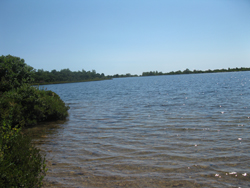
After taking a break at the shore of the lake, return to the Loop Road and turn right. Soon, you’ll reach a junction marked by a wooden sign. Turn left here and begin to follow the High Point Road, which begins as a wide gravel road. In 0.4 mile, you’ll notice a sign on the left that marks the start of the yellow-blazed Indian Rock Trail. Turn left and follow this trail, which crosses a wet area on a long set of puncheons and continues through pitch pines, with a dense understory of blueberries.
In about a third of a mile, the trail curves to the right, with an open rock ledge straight ahead. Walk out to the ledge, which offers a panoramic view to the west and north. The mountains you see to the right are the Catskill Mountains, including Slide Mountain, the highest in the Catskills. You’ll want to stop here and enjoy the broad scenic view.
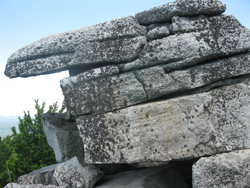 Continue ahead on the Indian Rock Trail, which now begins a winding downhill course. In another quarter of a mile, you’ll emerge on an open expanse of rock. Watch carefully for the blazes, which take you down through a narrow crevice and lead out to Indian Rock, for which the trail is named. This large fractured boulder is perched near the top of a cliff and balanced on a smaller boulder. There are views to the west and north from the base of the boulder, but the viewpoint you passed along the way offers broader views.
Continue ahead on the Indian Rock Trail, which now begins a winding downhill course. In another quarter of a mile, you’ll emerge on an open expanse of rock. Watch carefully for the blazes, which take you down through a narrow crevice and lead out to Indian Rock, for which the trail is named. This large fractured boulder is perched near the top of a cliff and balanced on a smaller boulder. There are views to the west and north from the base of the boulder, but the viewpoint you passed along the way offers broader views.
After spending some time at this fascinating boulder, retrace your steps back to the High Point Road and turn left. In another three-quarters of a mile, the improved gravel road ends and the road becomes grassier and somewhat narrower. Just beyond, you’ll come to a west-facing view, with a bench for those who wish to take a break. Continue ahead on the High Point Road, soon passing a view, on the right, of High Point, which you’ll soon climb.
In another half mile, you’ll come to a junction, marked by a wooden sign. Ahead, High Point Road is somewhat overgrown, and you should turn right, now following the red-blazed High Point Trail, which will be your route for the next 2.5 miles. Most of the blazes are painted on the rocks on the footpath, but you will also notice some blazes on trees along the way.
The trail begins by climbing rather steeply to a T-intersection. Here, the blue-blazed Berry Picker Trail begins on the left, but you should turn right to continue on the red-blazed High Point Trail, which is now joined by the Long Path (along the route of the High Point Trail, the Long Path is marked only by occasional logo blazes). In a short distance, you’ll emerge onto a panoramic viewpoint from an open rock ledge, with views to the west and north. You’ll want to stop briefly to take in the view, but don’t spend too much time here, as you’ll soon come to an even more spectacular viewpoint. Continue along the High Point Trail, which ascends very gently through dense stands of pitch pine. In about a quarter of a mile, you’ll reach High Point, the highest point in the area (2,240 feet), marked by a USGS benchmark.
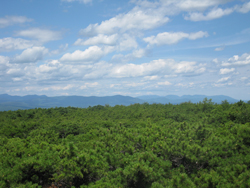 Although it is not the highest point in the Shawangunks (that point, elevation 2,289 feet, is just to the west of the High Point Road a short distance north of the Loop Road), High Point offers a panoramic 360-degree view. To the north, you can see the Catskills, with Slide Mountain and the Burroughs Range in the foreground, and the peaks of the Devil’s Path (Plateau, Sugarloaf, Twin and Indian Head) to the right in the distance. The radio towers you passed previously are visible to the southwest, and to the northeast, you can see Gertrude’s Nose in Minnewaska State Preserve. The Hudson Highlands can be seen to the east, and on a clear day, you might even get a glimpse of the Hudson River. Although High Point is surrounded by a dense growth of pitch pines, the trees grow only about six feet high in this harsh environment, so you can easily see in all directions over the treetops.
Although it is not the highest point in the Shawangunks (that point, elevation 2,289 feet, is just to the west of the High Point Road a short distance north of the Loop Road), High Point offers a panoramic 360-degree view. To the north, you can see the Catskills, with Slide Mountain and the Burroughs Range in the foreground, and the peaks of the Devil’s Path (Plateau, Sugarloaf, Twin and Indian Head) to the right in the distance. The radio towers you passed previously are visible to the southwest, and to the northeast, you can see Gertrude’s Nose in Minnewaska State Preserve. The Hudson Highlands can be seen to the east, and on a clear day, you might even get a glimpse of the Hudson River. Although High Point is surrounded by a dense growth of pitch pines, the trees grow only about six feet high in this harsh environment, so you can easily see in all directions over the treetops.
When you’re ready to continue, follow the High Point Trail as it steeply descends from the rock ledge and continues through a dense stand of pitch pines, with an understory of blueberries. For the next mile, you’ll follow a footpath through the dense pines and blueberries, with several steep descents of rock ledges and occasional views to the right. After about a mile, you’ll emerge onto a rock outcrop which offers panoramic views to the west and south. To the southwest, across the valley, you can see the radio towers that you passed earlier in the hike, and the Wallkill Valley is visible to the south. For the next half mile, you’ll be following a dramatic escarpment, with many views along the way. Finally, the High Point Trail goes back into the woods and descends to reach a T-intersection, marked by a sign.
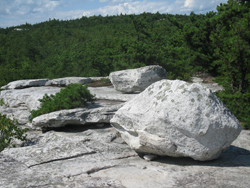 The light-blue-blazed Scenic Trail begins on the left, but you should turn right, following the Verkeerder Kill Falls Trail (also the route of the Long Path). The trail is now marked with the aqua blazes of the Long Path. You will note that the pitch pines that you’ve seen for most of the hike have been replaced by deciduous trees in this area. A short distance ahead, you’ll come to a fork. The Verkeerder Kill Falls Trail bears left here, but you should take the right fork, which leads to a exposed rock ledge, with two glacial erratics, that offers views to the west and south.
The light-blue-blazed Scenic Trail begins on the left, but you should turn right, following the Verkeerder Kill Falls Trail (also the route of the Long Path). The trail is now marked with the aqua blazes of the Long Path. You will note that the pitch pines that you’ve seen for most of the hike have been replaced by deciduous trees in this area. A short distance ahead, you’ll come to a fork. The Verkeerder Kill Falls Trail bears left here, but you should take the right fork, which leads to a exposed rock ledge, with two glacial erratics, that offers views to the west and south.
Return to the trail and follow it as it descends, steeply in places, towards the falls. As you approach the falls, the trail turns right, but you should continue ahead to a rock ledge overlooking the 180-foot-high Verkeerder Kill Falls – the highest waterfall in the Shawangunks. Use extreme care, as there is a sheer drop from here to the bottom of the falls! The falls are most dramatic after heavy rains, and might be reduced to a trickle in times of drought.
You’ll want to take a break here to appreciate this natural wonder. When you’re ready to continue, turn left on the Verkeerder Kill Falls Trail/Long Path, which almost immediately crosses the braided Verkeerder Kill above the falls. Crossing the stream on rocks is usually very easy, but it can be challenging if the water is high.
The trail now begins a gradual climb to the Loop Road near Sam’s Point. You’ll be gaining about 500 feet in elevation over the next two miles, but most of climb is gentle. At first, you’ll pass through an area dominated by tall deciduous trees – a contrast to the stunted pitch pines that have surrounded the trail for most of the way. When you reach the 2,100-foot contour, the pitch pine-blueberry forest returns.
Just beyond, the trail makes a sharp left turn (the overgrown path to the right, now abandoned, once led to the Loop Road near Lake Maratanza). The trail now levels off, and a short distance beyond, the vegetation changes to a birch forest with an understory of ferns. After the trail crosses an intermittent stream (the outlet of Lake Maratanza), the pitch pine/blueberry forest resumes, and the trail climbs some more.
Soon, views appear to the northeast over Minnewaska State Park Preserve. The three rock formations that you see are (left to right) Castle Point, Hamilton Point and Gertrude’s Nose. After bending to the right and passing through an area dominated by blueberry bushes, with only occasional pitch pines, the Verkeerder Kill Falls Trail ends at a junction with the road that leads to the Ice Caves. If you’d like to visit the Ice Caves, turn left on the road, but if you’ve done enough hiking for the day, turn right and head uphill to the Loop Road, where you should turn left.
Follow the Loop Road (here, a deteriorated paved road) for about half a mile until a wide road goes off to the right. Turn right and follow this road for about 250 feet to Sam’s Point, which offers panoramic views to the southwest. Legend has it that, during the French and Indian War in the 1750s, a frontiersman named Sam Gonsalus leaped off this promontory to escape from Native Americans and landed safely in the bushes below. To prevent modern-day visitors from attempting the same feat, a stone wall has been erected around the lookout point.
Return to the Loop Road, turn right, and follow the road as it descends on switchbacks below the cliffs of Sam’s Point and returns to the Conservation Center and the parking area where the hike began.
Publication: Submitted by Daniel Chazin on 08/08/2013
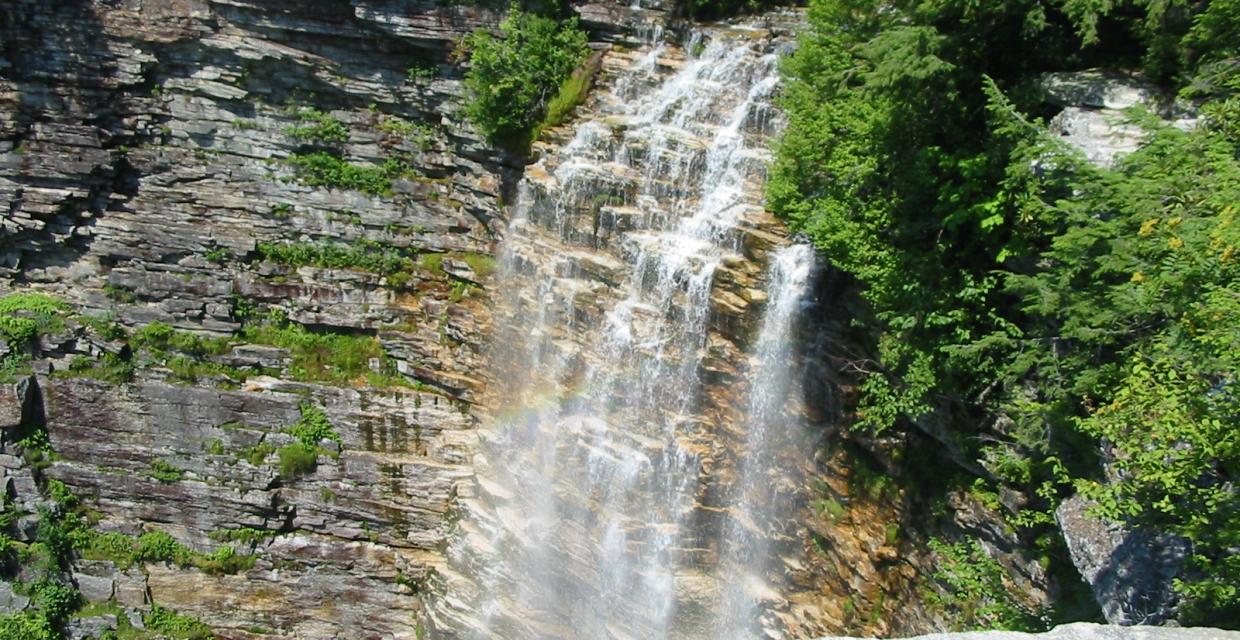
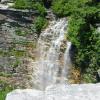
This loop hike climbs to Indian Rock, High Point and Verkeerder Kill Falls, with many spectacular views.
Hike Checklist:
Whether you are going for a day hike or backpacking overnight, it is good practice to carry what we call The Hiking Essentials. These essentials will help you enjoy your outing more and will provide basic safety gear if needed. There may also be more essentials, depending on the season and your needs.
The Essentials
Hiking Shoes or Boots
Water - Two quarts per person is recommended in every season. Keep in mind that fluid loss is heightened in winter as well as summer. Don't put yourself in the position of having to end your hike early because you have run out of water.
Map - Know where you are and where you are going. Many of our hiking areas feature interconnecting network of trails. Use a waterproof/tear-resistant Tyvek Trail Conference map if available or enclose your map in a Ziplock plastic bag. If you have a mobile device, download Avenza’s free PDF Maps app and grab some GPS-enhanced Trail Conference maps (a backup Tyvek or paper version of the map is good to have just in case your batteries die or you don't have service). Check out some map-reading basics here.
Food - Snacks/lunch will keep you going as you burn energy walking or climbing. Nuts, seeds, and chocolate are favorites on the trail.
Sunscreen and insect repellent
Rain Gear and Extra Clothing - Rain happens. So does cold. Be prepared for changing weather. Avoid cotton--it traps water against your skin and is slow to dry. If you are wearing wet cotton and must return to your starting point, you risk getting chills that may lead to a dangerous hypothermia. Choose synthetic shirts, sweaters and/or vests and dress in layers for easy on and off.
Compass - A simple compass is all you need to orient you and your map to magnetic north.
Light - A flashlight or small, lightweight headlamp will be welcome gear if you find yourself still on the trail when darkness falls. Check the batteries before you start out and have extras in your pack.
First Aid Kit - Keep it simple, compact, and weatherproof. Know how to use the basic components.
Firestarter and Matches - In an emergency, you may need to keep yourself or someone else warm until help arrives. A firestarter (this could be as simple as leftover birthday candles that are kept inside a waterproof container) and matches (again, make sure to keep them in a waterproof container) could save a life.
Knife or Multi-tool - You may need to cut a piece of moleskin to put over a blister, repair a piece of broken equipment, or solve some other unexpected problem.
Emergency Numbers - Know the emergency numbers for the area you're going to and realize that in many locations--especially mountainous ones, your phone will not get reception.
Common Sense - Pay attention to your environment, your energy, and the condition of your companions. Has the weather turned rainy? Is daylight fading? Did you drink all your water? Did your companion fail to bring rain gear? Are you getting tired? Keep in mind that until you turn around you are (typically) only half-way to completing your hike--you must still get back to where you started from! (Exceptions are loop hikes.)
Check the weather forecast before you head out. Know the rules and regulations of the area.
The Leave No Trace Seven Principles
Plan Ahead and Prepare
- Know the regulations and special concerns for the area you'll visit.
- Prepare for extreme weather, hazards, and emergencies.
- Schedule your trip to avoid times of high use.
- Visit in small groups when possible. Consider splitting larger groups into smaller groups.
- Repackage food to minimize waste.
- Use a map and compass to eliminate the use of marking paint, rock cairns or flagging.
Travel and Camp on Durable Surfaces
- Durable surfaces include established trails and campsites, rock, gravel, dry grasses or snow.
- Protect riparian areas by camping at least 200 feet from lakes and streams.
- Good campsites are found, not made. Altering a site is not necessary.
- In popular areas:
- Concentrate use on existing trails and campsites.
- Walk single file in the middle of the trail, even when wet or muddy.
- Keep campsites small. Focus activity in areas where vegetation is absent.
- In pristine areas:
- Disperse use to prevent the creation of campsites and trails.
- Avoid places where impacts are just beginning.
- Pack it in, pack it out. Inspect your campsite and rest areas for trash or spilled foods. Pack out all trash, leftover food and litter.
- Deposit solid human waste in catholes dug 6 to 8 inches deep, at least 200 feet from water, camp and trails. Cover and disguise the cathole when finished.
- Pack out toilet paper and hygiene products.
- To wash yourself or your dishes, carry water 200 feet away from streams or lakes and use small amounts of biodegradable soap. Scatter strained dishwater.
- Preserve the past: examine, but do not touch cultural or historic structures and artifacts.
- Leave rocks, plants and other natural objects as you find them.
- Avoid introducing or transporting non-native species.
- Do not build structures, furniture, or dig trenches.
- Campfires can cause lasting impacts to the backcountry. Use a lightweight stove for cooking and enjoy a candle lantern for light.
- Where fires are permitted, use established fire rings, fire pans, or mound fires.
- Keep fires small. Only use sticks from the ground that can be broken by hand.
- Burn all wood and coals to ash, put out campfires completely, then scatter cool ashes.
- Observe wildlife from a distance. Do not follow or approach them.
- Never feed animals. Feeding wildlife damages their health, alters natural behaviors, and exposes them to predators and other dangers.
- Protect wildlife and your food by storing rations and trash securely.
- Control pets at all times, or leave them at home.
- Avoid wildlife during sensitive times: mating, nesting, raising young, or winter.
Be Considerate of Other Visitors
- Respect other visitors and protect the quality of their experience.
- Be courteous. Yield to other users on the trail.
- Step to the downhill side of the trail when encountering pack stock.
- Take breaks and camp away from trails and other visitors.
- Let nature's sounds prevail. Avoid loud voices and noises.
The Trail Conference is a 2015 Leave No Trace partner.
(c) Leave No Trace Center for Outdoor Ethics: www.LNT.org.

